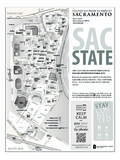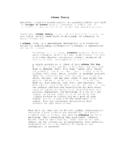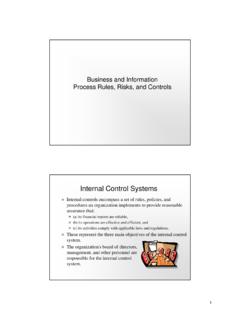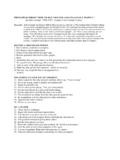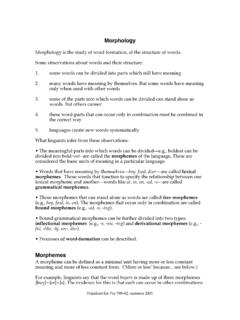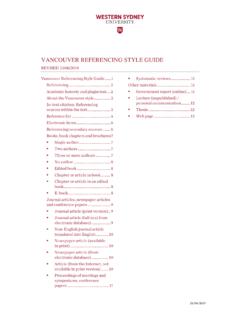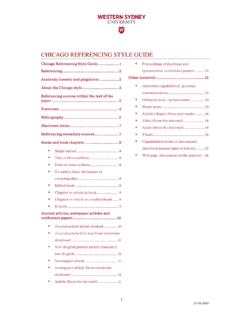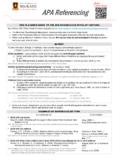Transcription of Industry Analysis - California State University, Sacramento
1 Industry Analysis Bakery Industry By: Annie Doolittle, Ashlee Jones, Lisa Pope, Oksana Vorontsov, Jeffrey Wray 12/12/2013. 1. Table of Contents Introduction ..3. Background ..3. Dominant Economic Characteristics ..4. Key Success Factors 11. Six Forces of Competition ..13. Competitive Position of Major Companies ..18. Industry Prospects and overall Attractiveness .31. Conclusion ..33. References ..34. 2. Introduction The baking Industry in the United states is those companies that focus on and manufacture baked goods. Mainly these baked goods consist of some type of bread but it can also included items such as cakes, cookies, crackers and pastries just to name a few. Baking is the act of making food such as cakes and breads by preparing a dough, batter, etc., and cooking it in an oven using dry heat (Merriam- webster Dictionary.) Other foods may be baked like meats, vegetables and some pasta dishes, but for the purposes of this Analysis we will be focusing on the baked goods that include breads, cakes etc.
2 Background Baking goes as far back as at least 2600 It is the Egyptians that are credited with using the baking technique first. They are also credited with the first use of leavening, or the use of yeast to make the dough rise, in bread. It was the Egyptians that also came up with the first ovens to bake these breads in. From Egypt, baking spread to ancient Greece and then into the Roman Empire where it flourished around the 3rd century and pastries became all the rage. Anyone that could produce a good pastry was highly sought after and by 1 there were over three hundred pastry chefs in Rome alone. With the widespread reach of the Roman Empire the technique of baking did not take too long to spread to other parts of the world. From Europe to Asia people started baking and it started to become a more common element of a person's daily life. Through most of Europe, street merchants popped up selling their freshly baked goods to passerbies. Some of the goods sold were cakes, gingerbread, and pancakes.
3 With the development of machines and the industrial revolution, baking developed into an Industry and really grew here in the United states as factories were built and the means of transporting the baked goods, such as the railroads, were established. The invention of the 3. modern day oven and ingredients such as preservatives and other food additives also played a big role in the spread of the popularity of baked goods. In the today the baking Industry accounts for over 600,000 jobs and over $102 billion a year. It is especially big here in the State of California with over 89,000 jobs that are directly related to the baking Industry with over million paid in wages to those workers. In 1897 the American Bakers Association was founded to be the voice of the baking Industry and to help grow and enhance the baking Industry . Today the American Bakers Association has grown to become one of the top trade associations, if not number one, for the baking Industry .
4 Today there are many companies in the baking Industry but really there are only a few major players on the baking Industry stage. Those will be discussed here in this report. Dominant Economic Characteristics Market Size The baking Industry plays an important role in the US economy, generating over 30. billion dollars of revenue in 2013. There are 2,800 commercial bakeries and 6,000 retail bakeries in the United states . This illustrates the scope and size of the Industry . While there are many bakeries in the US, the top four producers account for 35% of the Industry revenue and commercial producers account for 91% of the total revenue in the Industry . The Industry is fragmented due to the majority of firms in the Industry being small retail bakeries located throughout the Unites states . Scope of Competitive Rivalry The baking Industry is highly competitive because most bakeries are small to medium size producers that serve a highly fragmented market. Competition among the key players in the 4.
5 Industry is based on price, quality, differentiation, and nutritional value. Two major players in the baking Industry in the United states are Flowers Foods Inc. and Grupo Bimbo. Combined these two power companies make up of the baking Industry . A few of the smaller players in the Industry include Hostess Brands LLC, Krispy Kreme Doughnuts Inc., and Campbell Soup Co. The most important determinant of competition in the Industry is price. Consumers have high purchasing power, and the majority of small producers cannot compete with the lowest prices. Innovation and differentiating products is important to remain a strong competitor. The baking Industry is homogeneous and product differentiation is necessary to separate from competitors. Marketing initiatives must be a priority to increase demand, as brand recognition is another key competition factor. In addition, consumers are likely to pay more for a well-known brand. Market Growth The Industry has experienced slow growth in the last five years due to changes in consumer preferences and the economic downturn.
6 Although annual growth decreased .3% from 2008 to 2013, it is expected to increase by .7% from 2013 to 2018. This is because sales and revenue reflect the conditions of the economy, and disposable incomes have been rising. Big companies have grown exponentially in the last five years. This is due to acquisitions and mergers. Grupo Bimbo acquired Sara Lee and Weston Bread Unit, making it the largest baked 5. goods company in the US. Although the current market concentration is low, it is beginning to rise as the number of mergers and acquisitions increase. Currently, the baking Industry is at maturity in the Industry lifecycle. This means that bread and other baked goods are widely accepted by US households. As economic conditions and consumer preferences change, the baked goods Industry shows slow growth. Customers 99% of US households consume baked goods leading to a giant and diversified consumer base. Over the past five years, per capita disposable income has decreased and the US economy has limited growth in the baking Industry .
7 Consumers were mostly purchasing baked goods from supermarkets and wholesale outlets as opposed to consuming baked goods from restaurants. However this trend is predicted to change over the next five years, and in 2014 revenue is anticipated to grow As the recession is coming to an end American citizens are spending more time at work. Technomic's 2012 Snacking Consumer Trends Report explains that consumers are snacking more as they become busier over time. This will ultimately lead to a decrease in the purchasing of bread products because consumes will rely on substitute products such as nuts, yogurt, fruit and cereal bars. Companies in this Industry have the challenge of keeping up with America's constant changing consumer health trends. Consumers are becoming more health conscious and nutrition preferences are changing including gluten free, low-carbohydrate and Paleo diets. The pressures from consumers have led companies to increase product differentiation such as low-calorie, low- carbohydrate, and whole grain products.
8 Paleo, an all-natural raw food diet eliminated bread completely. Although these nutritious trends affect the baking Industry , their impact is small and 6. unlikely to change in the Industry significantly. Companies will continue to introduce new products that satisfy the consumers' nutritious preferences. Degree of Vertical Integration Firms in the baking Industry use forward vertical integration. Because producers seek other suppliers for flour, dairy products, sugar and many other ingredients to create its products, backward integration is not used. Retail bakeries manufacture and wholesale their products. While commercial bakeries usually have extensive distribution networks, they do not directly sell to the final consumers. Instead they distribute their products to supermarkets, restaurants, specialty food stores, and convenience stores, just to name a few. In fact, the largest downstream market for this Industry 's market is supermarkets, grocery stores and wholesale clubs, accounting for of revenue in 2013.
9 Access to these downstream markets is crucial for the success of the large firms in this Industry . Vertical integration has many benefits and drawbacks for the baking Industry . Using vertical integration improves the coordination of the supply chain for both small and large firms. Small firms are able to manufacture and wholesale their products while large firms have invested in extensive distribution networks with retail outlets. In addition, large firms are able to gain access to downstream markets that greatly increase their sales. Also, supply and demand is synchronized with vertical integration. A downside of using forward vertical integration is the cost. Developing, establishing, and maintaining a successful distribution network requires time as well as increased monetary capital. Ease of Entry/Exit The ease of entry into the baking Industry is high and the barriers to entry in the baking Industry are low including initial capital investment, competition with key players, and 7.
10 Relationships with major retailers. Initial capital investments can be extremely high depending on the necessary scale of production, therefore deterring new entrants. The largest barrier that new entrants face is having to compete with the key players, such as Flower Foods Inc. and Grupo Bimbo, who have already developed their reputation, customer loyalty and brand recognition. Success from new entrants often comes from low products and concentrated geographic areas. Another major barrier to entry is obtaining relations with major supermarkets that have already given shelf space to developed brands. Unfortunately costs are high as small entrants introduce their products with small independent markets and local bakeries. Due to the market concentration being low and extremely fragmented, the ease of exit in this Industry is high. Technology and Innovation Technology and innovation have drastically changed the baking Industry . New production techniques, e-commerce, and product development have shaped the current operations of firms in the Industry .
